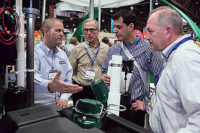If you knew exactly how much you were going to sell in the future of each of the items you stock, you could definitely reduce your inventory, right?
That precise knowledge of your upcoming demand would mean you would not have to keep “buffer stock” in your inventory for unforeseen sales spikes. On the other hand, by stocking exactly what your customers were going to buy, you would also not have any out of stocks, so you would not lose any sales from not having product in stock.
Of course, in the real world it is impossible to have 100% forecast accuracy. But is it possible to improve your forecast accuracy by 3%? How much financial impact would that have? How do you measure it? Is it worth the effort?
Opportunity for profits
As for the financial impact of increasing forecast accuracy, there have been several studies to estimate what kind of impact an increase in forecast accuracy has on your profitability.
The Supply Chain Council studied 67 companies and found a definite correlation between higher forecast accuracy and higher fill rates (see Figure 1).
Improved fill rates translates into fewer lost sales and fewer backorders, which results in increased revenues.
While improving fill rates, improved forecast accuracy also lowers inventory levels measured in days of sales (see Figure 2).
So improved forecast accuracy simultaneously improves fill rates and lowers inventory.
Now let’s discuss how this translates into increased profitability. When analysts have studied companies that were best-in-class in demand forecasting, they found these companies average, according to AMR Research, 15% less inventory; 17% higher perfect order fulfillment; 35% shorter cash-to-cash cycle times; and 1/10 the stock outs of their peers. In addition, every 3% increase in forecast accuracy increased profit margin by 2%.
These improvements in inventory efficiencies then translate into improved financial metrics (according to AMR Research), including 10% improvement in earnings per share; 5% increase in return on assets; and a 2.5% gain in profits.
So indeed, an improvement in demand forecasting has significant impacts on a business, driving all the way to the bottom line.
Measuring the improvement
How does a company get started on a path to improved forecast accuracy? Unfortunately, most supply houses and master distributors do not track their forecast accuracy or forecast error. That is because most ERP systems used by distribution companies do not actually create a forecast that predicts the future sales for each SKU. Instead, they estimate usage based on recent sales history.
The first step in improving your forecast accuracy is to do an initial calculation of your current forecast accuracy to establish a basis for improvement. This is actually a pretty easy process.
Have your IT guy (or whoever is most familiar with your ERP system in your company) export a report of the “usage” number (or forecast if you have it) by SKU from your ERP system. You may have to get a support person from your ERP provider to do it for you.
If you can get that report with the usage for the prior month, that’s perfect. If you only can get it for the current month then save that file until the end of the month. You can import it into a spreadsheet so you can calculate the forecast accuracy. If you have multiple stocking locations, you may want to start with “rollups” of the items across all locations.
It should look something like what is shown in Figure 3.
Once your actual sales (demand) for that same timeframe are available for reporting, get that report by item. If you sort both reports by item number, hopefully you can copy the actual demand to the spreadsheet as another column (see Figure 4).
Now you have what you need to calculate the forecast accuracy. The forecast accuracy calculation is:
1 – (the absolute value of (Actual Demand – Forecast) / Actual Demand)
You can see the cell calculation in the graphic in Figure 5 in the additional column for ERP Accuracy.
Copy that formula to each cell in the column and now you have your item level forecast accuracy numbers! You can aggregate these numbers to other rollup groupings for meaningful metrics. For example, you can subtotal by product categories to drill down on areas where you are doing better and where you are doing worse. If you total the columns with actual demand and usage, you can calculate your aggregate item forecast accuracy.
There are many other forecast accuracy and error metrics you can use that we will not go into in this article. A few of the many that you can use to measure and monitor your progress include forecast error, mean absolute percent error (MAPE), mean average deviation (MAD) and MAD percent.
After you establish a basis for item level forecast accuracy, you then should recalculate your forecast accuracy on a regular basis, ideally every month. If you share this data with key personnel, you can start working on improving these numbers and make sure they are not getting worse.
Even if you have a good forecasting system and processes, for various reasons the forecasts can get off-track. Your business can have a couple months of slow sales. Or on the other hand, you could have consecutive record months in sales. This could be an anomaly or it could be a trend.
How to improve
If you’ve followed along and measured your forecast accuracy, you’ve already taken the most important step: calculating your current forecast accuracy. To give you a gauge of how you stack up vs. other companies, if your aggregate item forecast accuracy is above 80% then you are doing pretty well, especially compared to your competition.
If you are below 50%, there definitely is room for improvement. Most PHCP supply house and master distributors are not creating actual forecasts by SKU, and the usage number in their ERP system runs between 25% and 50% accurate as a forecast vs. the month’s actual demand.
The biggest challenge for supply houses and master distributors is that you stock thousands of items, which makes it very difficult to improve your forecast accuracy by human review alone.
If your forecast accuracy is poor, you will probably have to turn to technology, and you may want to start investigating inventory forecasting systems to supplement the functionality in your ERP system. The worse your forecast accuracy, the bigger impact a good forecasting system will have on your inventory performance and profitability.
Have the prospective inventory forecasting vendor run some sample forecasts with your data so you can evaluate their accuracy and calculate a return on investment. If their accuracy is not much better than what you are getting now, that would obviously be a bad investment of time and money. For benchmark purposes, modern forecasting science can generate aggregate SKU forecast accuracy at above 80% and even above 90%.
Benefits of improvement
There is a proven opportunity for significant financial impact from improving forecast accuracy. We have seen distribution companies reduce lost sales by 70% through improving their SKU level forecast accuracy. Generally speaking, improved forecast accuracy enables a more precise alignment of the inventory investment to upcoming demand. Your business can react quicker to changes in the market, making your business more agile.
Specifically at an SKU level, the quantities of inventory you purchase and stock for each SKU will more accurately reflect what you are going to sell, increasing your cash flow and profitability.
Author bio: Rick Morris is a Certified Supply Chain Professional and founder of Thrive Technologies, a provider of cloud-based inventory forecasting and replenishment systems to distribution-intensive companies. He can be reached at 770/222-8599, ext. 106 or at rmorris@thrivetech.com.
HELPFUL LINKS:








